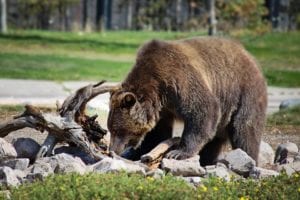 Grizzly bear is a North American brown bear – the most formidable predator of the New World. In the event of an attack on an unarmed person, the victim does not have the slightest chance of salvation, because the grizzlies, despite their external awkwardness, are quick and enduring. But a bear cannot oppose anything to a man with a gun.
Grizzly bear is a North American brown bear – the most formidable predator of the New World. In the event of an attack on an unarmed person, the victim does not have the slightest chance of salvation, because the grizzlies, despite their external awkwardness, are quick and enduring. But a bear cannot oppose anything to a man with a gun.
To date, the area of the grizzly bear in the United States has decreased to 2% of its original area. Bear populations are preserved in the national parks of the country – Yellowstone, Denali and Glacier. Since the habitat of animals is not too extensive, at times to reduce the population of bears allow seasonal hunting.
Grizzly may fear nothing
Last year, the US Fish and Wildlife Service determined that grizzly bears are no longer on the list of endangered species to which they were included in 1975, which means hunting is allowed. Quite possibly, this was due to the fact that in four years in the territory of Yellowstone National Park and in its vicinity three attacks by bears of people with a fatal outcome occurred at once, and several episodes of grizzly attacks on cattle were recorded.
Despite the fact that local authorities promised to establish quotas for the number of animals that were taken (according to preliminary information, in the states of Wyoming and Idaho, these figures were 23 heads each) and to stop all attempts to go beyond them, this initiative was challenged immediately by six lawsuits. Parties to animal protection organizations and Indian tribes inhabiting the north-west of the country. Indeed, even taking into account the fact that the bear population of Yellowstone National Park has grown significantly over forty years, and today is about 700 individuals, it still remains quite low in comparison with the area inhabited by animals.
The animal defenders did not associate the grizzly attacks on tourists, not with the growing number of bear populations, but with the fact that the number of visitors to the national park has increased significantly, and they do not always take precautions, often going alone to the forest.
As part of a meeting in Montana, federal judge Dana Christensen decided to cancel the verdict of the Fish Resources and Wildlife Service and renew the ban on hunting for Yellowstone bears, returning the grizzly protected status two days before the first hunting season of these animals since 1991.
The judge said that the population of 700 individuals is negligible compared to what the population of grizzly bears was in the nineteenth century, and it is too early to say that the United States grizzlies are out of danger. Alas, the residents of Wyoming and Idaho, who are now preparing to go on a campaign for trophies, will now have to look for new prey.
Alternative opinion
The grizzly bear is the largest subspecies of the brown bear.
The National Rifle Association, the Wyoming Farms Bureau, as well as members of hunting associations have already expressed their dissatisfaction with the decision of Christensen. All of them see grizzly bears in the first place as a huge threat to humans and livestock: since these animals are not afraid of people, having multiplied in large numbers, they can begin to terrorize the settlements located near Yellowstone National Park. Canada has been suffering from a bear problem for many years – animals come to feed on landfills, allowing citizens to go outside, hunt cows and sheep, destroy crops in gardens and fields.
Whether Christensen was right, leaving behind the Yellowstone Grizzlies a protected species status will be shown in the coming years. If the statistics of attacks on people and livestock do not begin to grow rapidly, then the bears can live in peace in the national park for a very long time.
Picture Credit: jill111